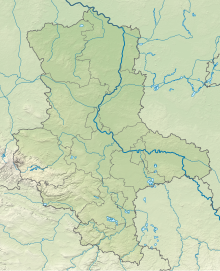Wendelstein (Kaiserpfalz)
Coordinates: 51 ° 16 ′ 35 ″ N , 11 ° 28 ′ 5 ″ E
The Wendelstein is a nature reserve in the municipality of Kaiserpfalz in the Burgenland district in Saxony-Anhalt .
The nature reserve with the registration number NSG 0272 is about 100 hectares . A part of the nature reserve is part of the approximately 6 hectare FFH area "Trockenrasen am Wendelstein". To the east it borders on the landscape protection area "Unstrut-Trias country." The area has been under protection since 2002 (date of regulation: November 20, 2002). The responsible lower nature conservation authority is the Burgenlandkreis.
The nature reserve is located west of Nebra (Unstrut) and southeast of Roßleben in the Saale-Unstrut-Triasland nature park . It places a section of the rather wide Unstrut Valley, formed here by leaching processes and gravel , as well as the 30 meter high gypsum slopes adjoining it to the north and the plateau of the Wendelstein castle hill under protection. The geotope of the southern slope of the Wendelstein is one of the most important natural daily outcrops of the Zechstein in southern Saxony-Anhalt. In the Unstruttal, the nature reserve comprises the course of the river with the adjoining floodplain , two oxbow lakes , the remains of a mill ditch and adjacent, predominantly agricultural areas. In the south, a still water created by gravel is included in the nature reserve.
On the plateau areas west of Wendelstein Castle, dry grass grows with real sheep fescue , upright bristle , golden thistle and field man's litter . The partially vertically sloping rocky slopes are populated by blue grass , fescue , spicy stonecrop , lichen and moss as well as rock rock, Baden bluegrass and awl grass . To the east of the castle hill is a larger orchard meadow .
The oxbow lakes of the Unstrut represent valuable biotopes . They are lined with reeds and bushes. Aquatic horn leaf communities and aquatic knotweed communities settle in the oxbow lakes. Here live z. B. Painter's mussel and pointed marsh snail . The floodplain areas are also the habitat of the spotted snail , the shark snail and the common amber snail . The banded demoiselle can also be found here. At the eastern of the two bayous falter Kopfweiden from breaking pastures . The course of the river is accompanied in parts by trees and bushes . Otherwise the floodplain of the Unstrut is mostly free of wood.
The dry lawns offer u. a. Short-winged sword insect , small heather grasshopper , blue-winged wasteland insect and common sickle insect habitat. The common sickle insect occurs here at its northern limit of distribution. Various butterflies are also native here, including the swallowtail , the sail butterfly , the wall fox , the Esparsette ram and the mallowed thickhead butterfly . The nature reserve is also characterized by a species-rich wild bee fauna .
The different biotopes in the nature reserve offer different bird species a suitable habitat. So here are red kite , marsh harrier , partridge , tufted duck , grebes , kingfishers , wren , reed warbler , reed bunting , Beutelmeise , Warbler , Yellow Wagtail , Nightingale , backed Shrike and Dorngrasmücke home. The nature reserve is used as a feeding habitat and resting place by the white stork , great crested grebe , purple heron , whooper swan and lapwing .
Within the reserve are still Hare , dwarf and pygmy shrew , grass snake , sand lizard , toad , lake , water, grass frog and newt to be found. In the unstrut, u. a. the bar that are below the weir change occurring stone gravel banks required as spawning habitat.
State road 214 runs through the nature reserve between Saubach and Roßleben.
See also
Web links
- Nature reserves in Saxony-Anhalt: Wendelstein State Administration Office Saxony-Anhalt
Individual evidence
- ↑ Dry grassland on Wendelstein (FFH area) Profiles of the Natura 2000 areas, Federal Agency for Nature Conservation



